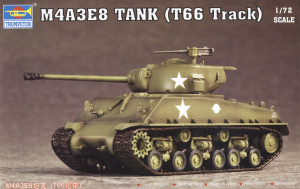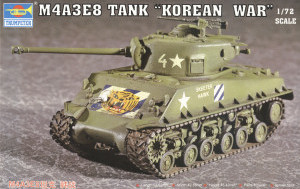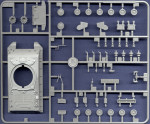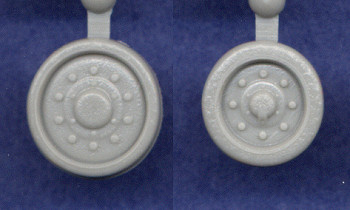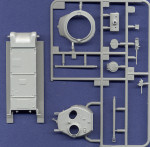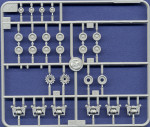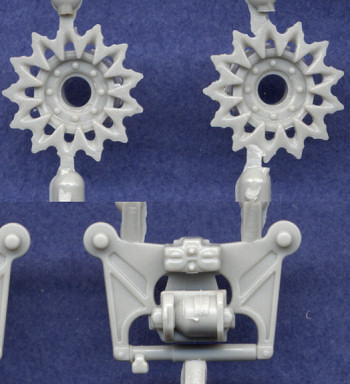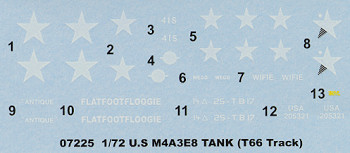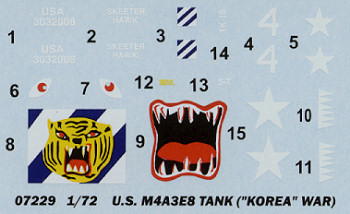Trumpeter Article by Doug Chaltry; last updated 1 December 2007.
Trumpeter is one of four companies to sell models of the M4A3E8 "Easy Eight" as this tank was called. Hasegawa has a 30-some year old kit that is unfortunately quite poor, leaving Dragon and UM to compete with these two Trumpeter kits. Although Dragon's kit is the definite winner in a side-by-side comparison with the Trumpeter kits, the Trumpeter models are far from being bad kits. This review covers both of Trumpeter's Easy Eights as these two kits are identical, with the exception of their tracks and their markings. Trumpeter's kits can be confusing at times. You never know what quality to expect until you actually open the box. While these Shermans aren't the worst kits that Trumpeter has released, they also don't match the quality of their FAMO or Elefant/Ferdinand kits. Generally speaking, these two kits are a little bit simplified, with closed crew hatches on the hull, rubber band tracks, details molded onto the hull such as pioneer tools, lift rings and tail lights. But then they have to confound us by putting very nice detail elsewhere, such as open crew hatches on the turret, pre-drilled gun barrel (did Dragon think they invented slide-molding?), and highly detailed wheels. So basically we have a pair of kits that aren't really up to competing with the Dragon Shermans, but can certainly be turned into very nice replicas if a little bit of effort is put into improving some of the kit details. This first sprue shows the upper hull, some wheels, and the hull's rear armored plate with exhaust parts. The hull measures out to be almost dead-on for the scale; it's length (without fenders) is perfect. The hull width without the extended side fenders is just about a millimeter too narrow, but with the fenders is about half a millimeter too wide, so that's pretty darned good. All of the hull details are appropriately located, though as I mentioned above, much is molded onto the hull that I wish would have been provided as separate parts. Although the crew hatches are closed, they're molded in pretty decent relief, and will look great when painted. The wheels look very nice, and are sized almost perfectly.
The exhaust parts are also very well done, though the storage rack for the rear hull plate is a little crude, as are the wooden boxes included for stoage. The gas cans, however, are really well done for a plastic kit, needing only replacement handles. The turret sprue is shown above next to the lower hull. Note that the nose piece is molded onto the lower hull, which is unusual for Sherman kits. This scan shows the only real flaw of this kit: the commander's hatch is far too large. The all-around vision cupola itself is about a mm too large in diameter, but the hatch opening is even worse, at a full 2mm too large in diameter. The visual effect can be lessened by gluing the commander's hatch closed, but when sitting next to another, more accurate kit, it will still probably be noticable. Solutions? Well, the Extratech Sherman kits, which all use the 75mm M4 turret, also include a cupola and hatch as spare parts that could be used on these Trumpeter kits instead. As for the loader's hatch, this turret represents the later T23 turret with the oval loader's hatch, and that hatch is far more accurate in size than the commander's cupola, being only a little bit too long. Two gun barrels are included (either M1A1C or M1A2 guns), one with the thread protector end cap, and one with the muzzle brake. They have open tips thanks to slide-molding. The gun with the thread protector is fairly accurate, being perhaps a millimeter too long, but the gun with the muzzle brake is a full 2mm too short. Luckily aftermarket gun barrels are available for replacements. The rotor shield looks a little plain, but is mostly accurate in size, being about 1.5mm too sort (left to right). I'll replace the lift rings on mine. The .50cal machinegun is well done and will look really good when the hand grips are carved open. The .30cal looks nice, though is a little small, and the ammunition box, which is molded onto the side of the gun (opposite the scan) is turned sideways for some inexplicable reason. The HVSS bogies are pretty decent, though not as detailed as the Dragon or UM kits in some areas. Two sprues are included: the one the left has the primary kit parts, and the one on the right has some simplified bogies, with the front wheels already molded onto the bogie frames. I assume these "quick-build" parts are for the use of wargamers? Whatever. Attaching two wheels to the bogie really doesn't save us a whole lot of time. Be aware that enough wheels are included to complete only one set of bogies, not both. The detail on these parts is OK; the spring detail is good from the side, but not on the top where much of the open space is filled with plastic. The sprocket is the mid style with the open cutouts and dimples in the metal plate behind each tooth. Trumpeter is the only company that gives us this style of sprocket.
And finally we get to the tracks, which are different between the two kits. The T-66 Track kit (#7225) not surprisingly includes the T-66 style of track. The Korean War kit (#7229) contains the T-80 track style. In both cases, the tracks are very nicely detailed, though about a millimeter too wide, and the soft vinyl in which they are molded is very soft, and will look pretty poor when mounted on the wheels. It is unfortunate that Trumpeter does not include hard plastic tracks in all of their kits as they did in their Elefant/Ferdinand kits. The decals for the two kits are also different. T-66 kit (#7225):
Included on this sheet are markings for three or more vehicles, but with placement locations for only one of them identified in the instructions (though no unit information). Time to break out your own reference material. I've been able to identify the following:
Korean War kit (#7229):
Similar to the T-66 kit, the Korean War kit includes two marking schemes, only one of which is depicted in the instructions, though not identified. In fact, both of the colorful markings are for Shermans that took part in Operation Ripper in early 1951 near the Han River. The cat on the left is for a vehicle of the 64th Tank Battalion, and the mouth on the right is for a Sherman in the 5th Infantry Div's tank company. The bumper codes included for the second vehicle are not completely correct: they read 5-T TK-IS, when in fact they should read 5-I TK45. So in conclusion, I like the Trumpeter Shermans a lot. They are much better than all other plastic Sherman kits out there, except for Dragon's, and using a little elbow grease will result in some very fine models. There are a few flaws, though nothing insurmountable, the biggest problem in my eyes being the lack of aftermarket tracks to replace the poor vinyl ones included in the kits. One final curiosity: does anyone ever read the sides of the kit boxes? I just realized that I normally don't, but when I was looking over these boxes trying to find some markings information, I noticed that the short historical paragraph is identical between the two kits, and is appropriate only for the Korean War kit. And even then, they state something curious: they say that there were two different styles of M4A3 engine decks, differing in the hinges of the engine access plate. They go on to say that parts for both engine decks are included in the kit, which is entirely false. |
